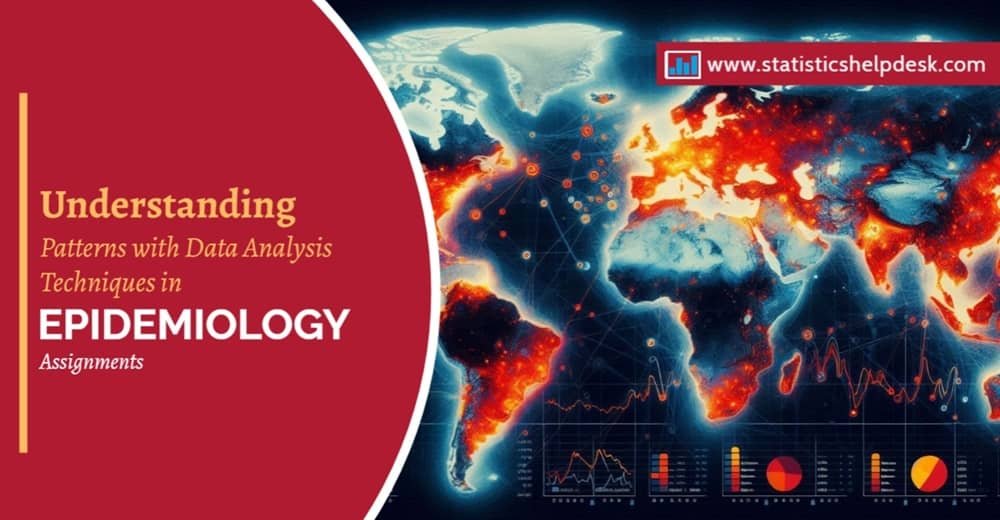Epidemiology, the study of how diseases spread and can be controlled, is vital in public health. Understanding epidemiological patterns is key to preventing as well as managing outbreaks. Epidemiology examines the patterns, causes, as well as effects of health and disease in the populations. Using data analysis techniques, we can better understand disease dynamics as well as enhances the public health responses. We will explore how these techniques are applied in the epidemiology with examples, coding snippets, as well as case studies. Additionally, we will discuss the importance of learning various statistical methods in addition to how epidemiology assignment help services can support this learning.

Epidemiology deals with the distribution and patterns as well as the causes of health as well as disease events that occur in populations. Its primary goals are to:
These patterns entail accumulating and analysing diverse data, including demographical data, health records, and various disease surveillance data.
Descriptive analysis mainly involves the use of statistics and visualization of data to understand the distribution of diseases. Common techniques include:
Example: Analyzing the spread of influenza in different age groups using bar charts and frequency distributions.
Inferential analysis uses statistical methods to draw conclusions from data samples. Key techniques include:
Example: Using regression analysis to determine the relationship between air pollution levels and asthma incidence.
COVID-19 has been a global health emergency, and hence, provided rich data in studying its epidemiology. Now let’s look at how some of the data analysis methodologies have been deployed to address this pandemic.
Data sources for COVID-19 include:
|
import pandas as pd import matplotlib.pyplot as plt
# Example: Plotting COVID-19 cases over time covid_data = pd.read_csv(´covid_data.csv´) covid_data[´date´] = pd.to_datetime(covid_data[´date´]) plt.plot(covid_data[´date´], covid_data[´cases´]) plt.xlabel(´Date´) plt.ylabel(´Number of Cases´) plt.title(´COVID-19 Cases Over Time´) plt.show() |
|
import statsmodels.api as sm
# Example: Linear regression analysis X = covid_data[[´social_distancing_index´]] y = covid_data[´cases´] X = sm.add_constant(X) model = sm.OLS(y, X).fit() print(model.summary()) |
|
from sklearn.ensemble import RandomForestRegressor
# Example: Predicting future cases with Random Forest features = covid_data[[´social_distancing_index´, ´mask_usage´]] target = covid_data[cases´] model = RandomForestRegressor(n_estimators=100) model.fit(features, target) future_cases = model.predict([[0.8, 0.7]]) # Example input print(f´Predicted future cases: {future_cases}´) |
Epidemiology has evolved due to the ability to deal with big data. For instance, information derived from the use of mobile phones can reveal the population’s mobility and estimate the rate of diseases. This approach was successfully employed during the West Africa Ebola outbreak to analyze the human mobility patterns.
Realtime acquisition of data has led to the timely implementation of eradication techniques towards disease outbreaks. Some of the features include acquiring real time dashboards and also developing and implementing predictive models that assist those in the public health services to make sound decisions as soon as they are needed.
Epidemiology benefits from collaboration across disciplines. Economists, data scientists, and public health experts work together to develop models that predict disease spread and evaluate intervention strategies.
Students who are struggling to complete their epidemiology assignments involving statistics and data analysis, can benefit from our Epidemiology Assignment Help service. This service aims to provide self-explanatory solutions for epidemiology problems, data analysis methods and interpretation of outputs for a clear understanding.
Epidemiology and statistics cannot be separated. It allows you to gain reliable information on disease patterns for purposes of decision making based on the findings and modelling of disease outbreaks. Our service assists you in developing these skills so you can feel prepared for any epidemiology task.
Textbooks:
Research Papers:
The application of epidemiology in analysis of data can be a very useful practice that can help in improving public health response. Statistical analysis and big data allow us to learn about the dynamics of the diseases and their intervention methods. With Epidemiology Assignment Help you will be able to acquire the understanding of applying various statistical techniques to real life disease data through the application of statistical softwares like python and R.
1. What is the primary purpose of epidemiology?
The primary motives of epidemiological studies include: understanding the causes of diseases, establishing their frequency, analysing its course, assessing the effectiveness of interventions, and furnishing data for policy-making
2. How does data analysis help in epidemiology?
Data analysis is beneficial in organizing disease information, testing hypothesis, determining causes of the disease, and forecasting future outbreaks for efficient disease control.
3. What types of assignments can you help with?
Our services include epidemiological data analysis, writing research papers, case studies, as well as other assignments.
4. How do I get started?
All you need to do is share your assignment information with us, and we will give you a tailored solution.
5. Is the service confidential?
Absolutely. Our company guarantees absolute anonymity of each client.
Sign up for free and get instant discount of 12% on your first order
Coupon: SHD12FIRST